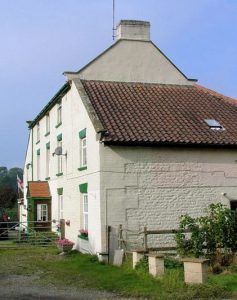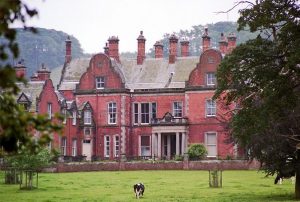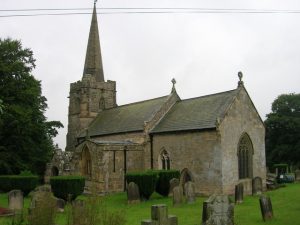
© Keith Allison, 2006
The parish of Ganton is situated in what was once the wapentake of Dickering, part of the historical East Riding of Yorkshire (see maps in Introduction). Before the 1832 parish boundary changes Ganton included the subparish of Potter Brompton and Ganton Dale Inn, a former posting house on the B1249, since renamed Ganton Dale House and now derelict.

Before the Conquest Ganton’s ploughlands, meadows and church were held by Morcar, all of which were in King William’s hands by 1086. A small estate was held by Robert de Brus soon after 1086 and a mesne lordship was held by the Percy family until at least the late 14th century. The Acklams were the demesne tenants of the estate from the mid 13th to the beginning of the 15th century, thereafter it passed through various hands until it was acquired by John Legard in 1586. It descended with the Legards, who became Ganton’s prominent family, until Sir Algernon Legard sold it to Harold Wrigley in 1911, and remains to this day in the ownership of the Wrigley family.
The manor house at Ganton was situated at the foot of the escarpment on which the church and main part of the village was built. It was described in 1586 as Elizabethan, “new builded, the walls of chalk-stone and covered with slate”. In the late 17th century it had thirteen hearths, but this number no doubt increased when the house was extended and partly rebuilt in the late 18th or early 19th century. This, however, did not save it from demolition when Ganton Hall was built from 1886 to 1888 further south and on a higher part of the escarpment. The present building is made of red brick with stone dressings and is Jacobean in style.


Ganton church is dedicated to St. Nicholas. It is considered 14th century though its chancel and transept arches date back to the 13th century, the chancel having been partly rebuilt during the restoration of 1843. The south porch and tower are 15th century, and the latter is crenellated and surmounted by a later octagonal spire. The Legard mortuary chapel is situated in the transept, blocked off – and locked off – from the nave by a carved screen. A baroque monument to John Legard (d1678) adorns the east wall, and there are several wall tablets to members of the Legard family elsewhere.
Morcar also held the estate at Potter Brompton until 1086. Like Ganton it passed to Robert de Brus, thererafter to Hugh Bigod and in 1166 William d’Aumale was holding it of the Bigods. It passed through the hands of various prominent families before being acquired through marriage by John Legard in 1630 and subsequently descended with Ganton manor.

© JThomas, 2009
The Pickerings of Kirk Ella, a probable offshoot of the Pickerings of Hackness 2, were farmers in Potter Brompton. This branch also farmed in Little Weighton, in the parish of Rowley, a neighbouring parish to Kirk Ella. The fact that members of the same family lived at the same time in two parishes situated at the northernmost and southernmost extremities of the East Riding can probably be explained by the Legard family becoming in 1100 lords of the manor of Anlaby (now partly in the parish of Kirk Ella), prior to acquiring the estate at Ganton, and the Pickerings being their tenant farmers. John Pickering of the 9th generation is a good example of this dichotomy: he was born in Kirk Ella in 1803, married in Rowley in 1830, but farmed all his life at Warren House Farm in Potter Brompton and was buried in Ganton in 1878.
William Coates Puckrin of the 12th generation of the Puckrins of Foston also farmed at Warren House Farm in the early 1870s, thus coinciding for a time with the Pickerings. (This begs the question whether the Pickerings and the Puckrins were related or perhaps believed they were.) He was buried along with his second wife in Ganton churchyard. His children were born in Potter Brompton and christened in Ganton church.
Sources:
https://www.genuki.org.uk/big/eng/YKS/ERY/Ganton
https://en.wikipedia.org/wiki/Ganton
https://opendomesday.org/place/SE9977/ganton
Victoria History of the County of York, East Riding, vol. 2, pp. 210-212 (not online)
Ganton Hall: https://historicengland.org.uk/listing/the-list/list-entry/1315745?section=official-list-entry
Church of St. Nicholas: https://historicengland.org.uk/listing/the-list/list-entry/1149689?section=official-list-entry
